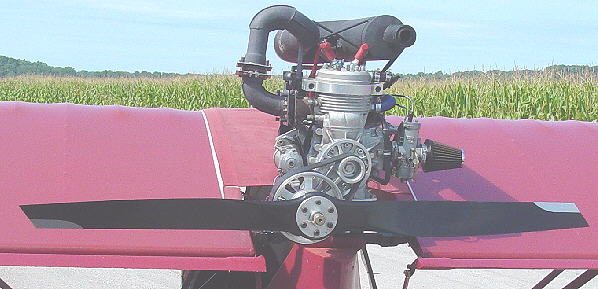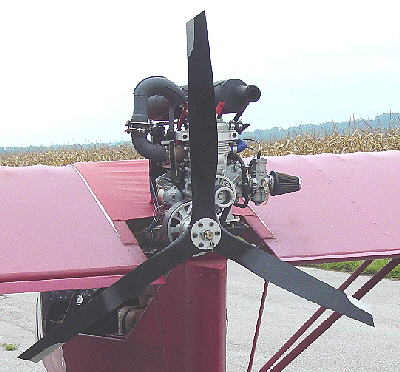|
|
 By modifying the propeller tips, and measuring a 5 db noise reduction from the uncut tips, I was curious as to what would happen if I added a third blade. One can see that with the lowered thrust axis, each blade of the two bladed propeller passes by its respective wing trailing edge at about the same time. I have received comments that the FireFly with this propeller configuration "sounds like a regular plane." I have assumed it was because at cruise the beat frequency would be about 3,852 beats per minute. This would sound like a four cylinder four stroke engine running at 1,926 rpm.
By modifying the propeller tips, and measuring a 5 db noise reduction from the uncut tips, I was curious as to what would happen if I added a third blade. One can see that with the lowered thrust axis, each blade of the two bladed propeller passes by its respective wing trailing edge at about the same time. I have received comments that the FireFly with this propeller configuration "sounds like a regular plane." I have assumed it was because at cruise the beat frequency would be about 3,852 beats per minute. This would sound like a four cylinder four stroke engine running at 1,926 rpm.
|
 A third blade was purchased, modified and mounted. One can see that the beat frequency of the individual propeller blades passing by the wing trailing edge is going to go up. Using AeroDesign Propeller Selector and keeping the air speed, and propeller rpm and diameter constant, I changed the number of blades from two to three, and I decreased the pitch until the thrust was the same as for the two blade propeller. This gave me an initial pitch setting of 15 degees (was 19 degrees for the two blade). The program indicated the propeller efficiency would go from 66.4% to 70.6%.
A third blade was purchased, modified and mounted. One can see that the beat frequency of the individual propeller blades passing by the wing trailing edge is going to go up. Using AeroDesign Propeller Selector and keeping the air speed, and propeller rpm and diameter constant, I changed the number of blades from two to three, and I decreased the pitch until the thrust was the same as for the two blade propeller. This gave me an initial pitch setting of 15 degees (was 19 degrees for the two blade). The program indicated the propeller efficiency would go from 66.4% to 70.6%.
The first take off was very interesting, in that one does not always realize how much you depend on how something sounds. As I opened the throttle, I thought the belt was slipping or the propeller had stalled. What had happened was the beat frequency had increased by three times, and I thought I was over reving the engine, but the tachometer indicated that this was not true. It took four flights with pitch adjusting in-between to get the engine to top out at 6,000 rpm. At an engine cruise speed of 5,200 rpm, it seems to fly just as fast as before. The db meter measured 105 db which is one less than before. Evidently the beat amplitude of the two blade propeller was much greater as the two blades passed the two trailing wing edges at about the same time, as opposed to three blades passing by each individual trailing edge. From the cockpit the pitch of the beat sound seems a little higher but not as loud as before. Also, this may be due to the fact that the blade pitch has been reduced from 19 to 13 degrees. Flew early in the morning to beat the thermals, and found the true (gps) speeds. They were:
I shortened the aileron push/pull tubes so that the ailerons could be reflexed to five degrees. On September 18, 2004, I flew up and down wind flights and obtained the following average gps speeds.
With the reflexed ailerons, I had to hold more forward stick to keep the FireFly from climbing than before. So the idea of reducing lift to reduce drag was invalid because the reflexing moves the center of lift so that one has to place greater load on the tail to keep from climbing. It appears that as one flies the FireFly at greater than trimmed engine cruise speed one has to add trim to the elevator control system. Another option would be to trim the FireFly out at max speed and accept whatever one gets for the desired engine cruise rpm. Also, one could raise the thrust line to see if it would push the nose down as the thrust increases and reduce the need for elevator trim and reduce high speed drag.
|